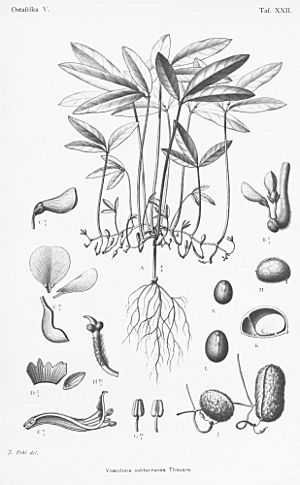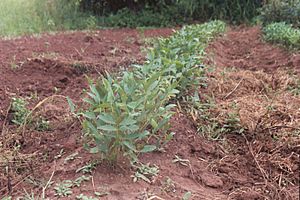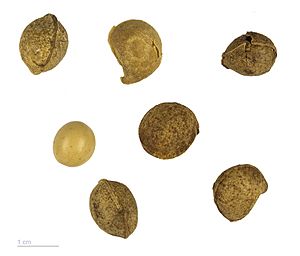Vigna subterranea facts for kids
Quick facts for kids Vigna subterranea |
|
|---|---|
 |
|
| Scientific classification | |
| Genus: |
Vigna
|
| Species: |
subterranea
|
| Synonyms | |
|
|
Vigna subterranea (common names: Bambara groundnut, Bambara nut, Bambara bean, Congo goober, earth pea, ground-bean, or hog-peanut) is a member of the family Fabaceae. The plant originated in West Africa. Vigna subterranea ripens its pods underground, much like the peanut (also called a groundnut). They can be eaten fresh or boiled after drying, and can be ground either fresh or dry to make puddings.
Contents
Agronomic aspects
Origin and cultivation
The origin of the Bambara groundnut is West Africa and the region of cultivation is Sub-Saharan Africa's warm tropics. Bambara nut grows well anywhere groundnut (peanut) grows, and so is vastly present from Kwara state, throughout the northern parts of Nigeria and Northern Ghana.
Importance
Bambara groundnut represents the third most important grain legume in semi-arid Africa. It is resistant to high temperatures and is suitable for marginal soils where other leguminous crops cannot be grown. It is a low-impact crop.
Bambara groundnut has nutritive value ranging between 57.9% to 61.7% carbohydrate and 24.0% to 25.5% protein content. It is considered to be a neglected and underutilized food source in Benin. It is reported an antimicrobial activity against Klebsiella pneumoniae, Pseudomonas aeruginosa, Staphylococcus aureus, Escherichia coli, Bacillus cereus, Candida albicans (yeast) and Aspergillus niger (mold).
The brown hull showed the highest concentrations of rutin and myricetin among flavonoids, while the red hull resulted in having with the highest concentrations of chlorogenic and ellagic acid among tannin compounds.
Uses
Culinary use
The seeds are used for food, beverages because of their high protein content and for digestive system applications. The entire plant is known for soil improvement because of nitrogen fixation. In West Africa, the nuts are eaten as a snack, roasted and salted, processed into cake, or as a meal, boiled similar to other beans.
In South Eastern Nigeria, particularly in Enugu, the dried bambara beans are ground into a fine powder, then mixed with palm oil, water and pumpkin leaves and then poured into banana leaf wraps or one-litre cellophane bags before being boiled into a pudding to make okpa, a common breakfast food. During the rainy season in many parts of central Nigeria, the fresh bambara beans are cooked with their shells still on them, then eaten as a snack.
Soil requirements
Optimal soils for Bambara groundnut production are sandy soils to prevent waterlogging. Optimal soil depth is between 50 and 100 cm, with a light soil texture. soil fertility should be low and soil pH is best suited between 5 and 6.5 and should not be lower than 4.3 or higher than 7.
Climate requirements
The production is best suited between a latitude of 20° - 30°, i.e. the tropical wet and dry (Aw) and the subtropical dry summer (Cs) climate zones. Optimal temperature is between 19 °C and 30 °C. Temperatures below 16 °C and above 38 °C are not suited for the production of bambara groundnut. The bambara groundnut is very drought-resistant. The minimal annual rainfall requirement is about 300 mm and optimal annual rainfall is between 750 mm and 1400 mm and should not exceed 3000 mm.
Cropping system
The cropping system is semi-permanent and the Bambara groundnut can be cultivated as single crop or as intercrop. Best suited intercrops are sorghum, millet, maize, peanut, yams and cassava.
Bambara groundnut is mainly cultivated as intercrop, however the planting density varies between 6 and 29 plants per square meter. For woodland savannas of Côte d'Ivoire the highest yield is attainable with a plant density of 25 plants per square meter.
Production
World production of Vigna subterranea increased from 29,800 tonnes in 1972 to 79,155 tonnes in 2015.
| Production Year 2013 (Source FAOSTAT) | Area Harvested (Ha) | Yield (kg/ha) | Production (tonnes) |
|---|---|---|---|
| 120,000 | 9,498 | 113,981 | |
| 68,000 | 4,412 | 30,000 | |
| 55,000 | 8,909 | 49,000 | |
| 43,392 | 8,444 | 36,639 | |
| 4,828 | 750 | 14,000 | |
| World | 315,392 | 7,724 | 243,620 |
Physiology
Growth
The growth cycle is between (min-max) 90–170 days and under optimal conditions the cycle is about 120–150 days to pod maturity. Flowers appear 40–60 days after planting. 30 days after pollination the pod reaches maturity and during another 55 days the seeds fully develop. Every 30 days they are produced again.
Generative reproduction
Generative reproduction is for the Bambara groundnut autogamous (self-fertilization) and cleistogamous (self-pollinating).




